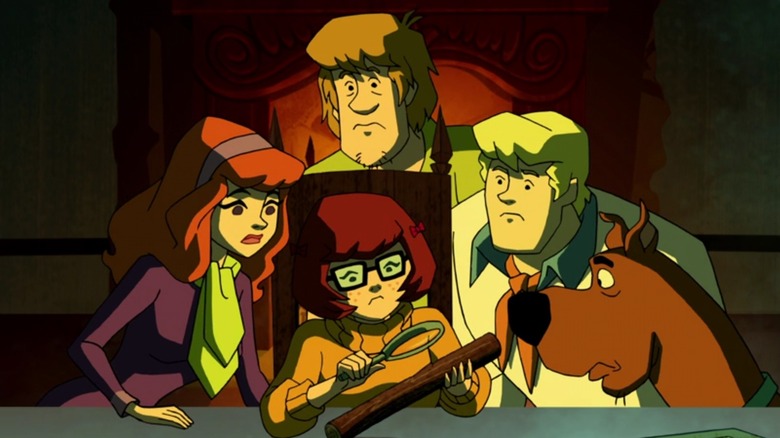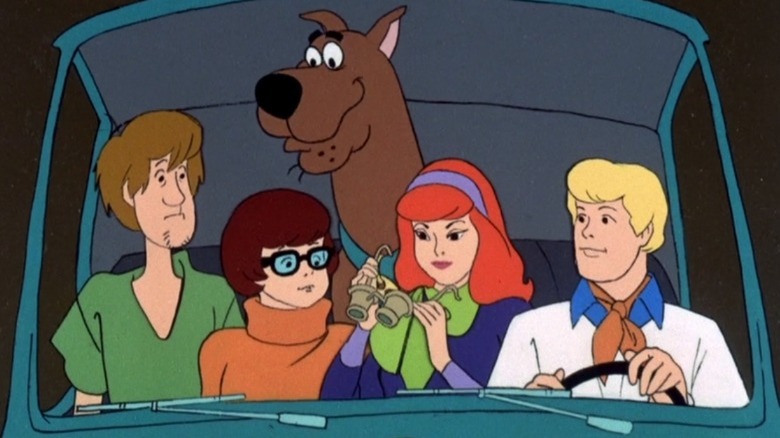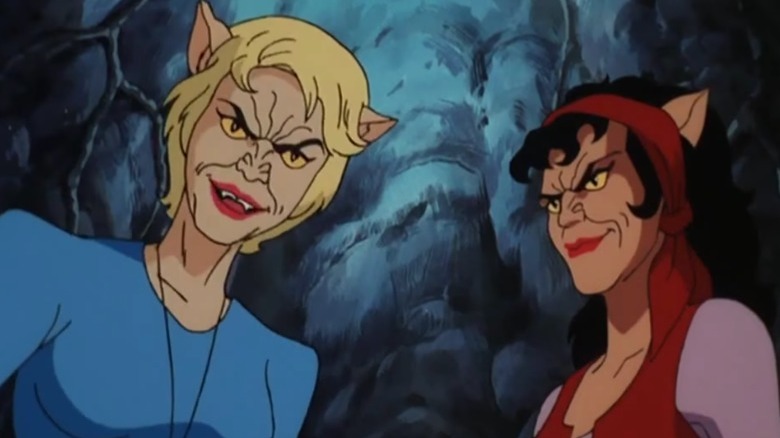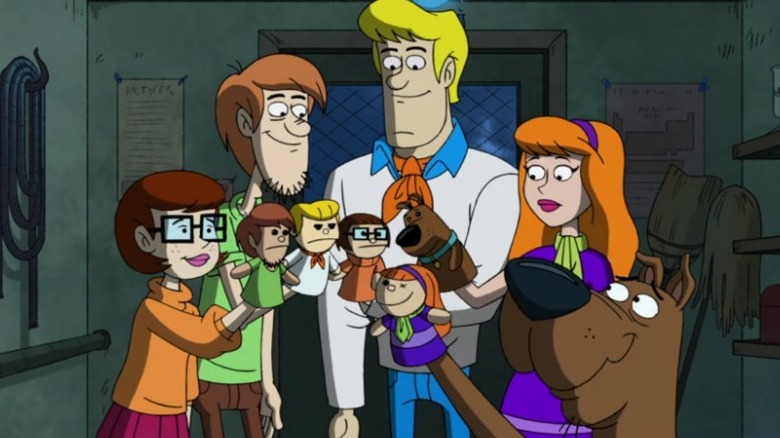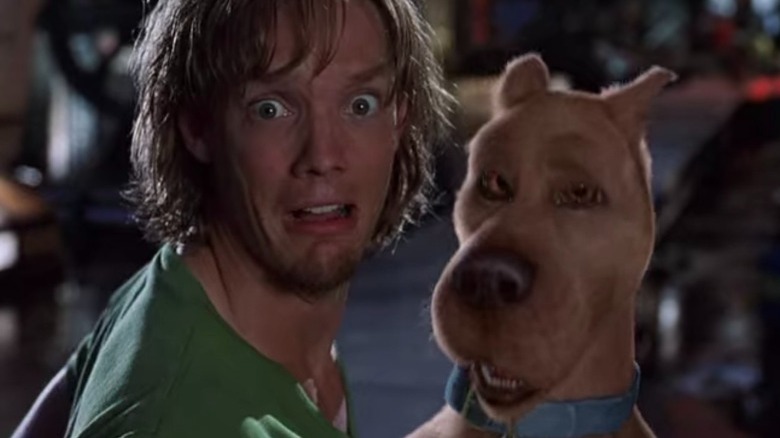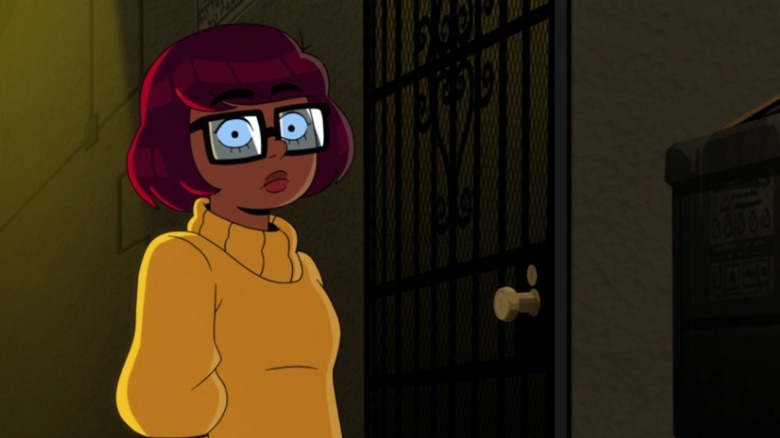The Key To Scooby-Doo's Longevity Is That It's Never Stopped Changing
When word got out that HBO Max was working on a Velma origin story, fan responses were all over the place. It's not that "Scooby-Doo" fans dislike the four-eyed, orange-clad investigator who's been integral to Mystery Inc. since it first began in 1969. Rather, the hesitant responses to "Velma" were related to other aspects of the Mindy Kaling-led show, including its adult humor and violence, changes in animation style and characterization, and a conspicuous lack of the crime-solving Great Dane himself. (And also the unfortunately expected racism from folks who decry progress as "woke," but that's another story.)
But if you look closely at the history of the long-running franchise, it's clear that for as long as Scooby and the gang have been on the air in some form or another, the shows have been repeatedly reinventing. And while that constant reinvention has often caused cyclical, ahistorical outrage from picky viewers, it's also the key to what makes "Scooby-Doo" so satisfying after all these years.
The 1969 classic set the standard
"Scooby-Doo" fans tend to hold each new incarnation of Mystery Inc. up to the original, the Hanna-Barbera cartoon "Scooby-Doo, Where Are You!" Despite its half-century-long cultural footprint, the first-ever Scooby-Doo series actually only aired for three seasons before finding a lasting home in syndication, where it reached multiple generations of viewers. The show's late writers Joe Ruby and Ken Spears modeled the now-iconic ensemble off of characters from one of the first teen-led sitcoms in TV history, the 1959 series "The Many Lives of Dobie Gray." Before it even started, the franchise was already about reinvention.
Still, the original "Scooby-Doo" didn't leave much room for episode-by-episode innovation. It was a groundbreaking animated work, one that inspired enduring archetypes and tropes that have been widely adopted, but if you attempt a serious watch-through as an adult, every episode feels nearly the same. There's something comforting about those beats "Scooby-Doo, Where Are You!" hits each and every time you tune in, from the bat-shrieking opening to its classic theme song to the chase sequences to the eventual unmasking of a greedy or ghoulish human foe disguised as a monster.
"Scooby-Doo" wasn't content to run on its quickly established hamster wheel for long, though. While some franchises value exhausting standardization, the Hanna-Barbera cartoon started tweaking its formula for maximum fun — and weirdness — almost immediately. In the early '70s, "The New Scooby-Doo Movies" were introduced, and the animated one-offs saw Fred, Velma, Daphne, Shaggy, and Scooby solving mysteries with real-life guest stars like the Harlem Globetrotters and Don Knotts, plus a roster of characters like Batman and Robin and Josie and the Pussycats. This collision between the real, the semi-real, and the fictional gave "Scooby-Doo" a meta sheen that it's carried through to many of its clever present-day iterations.
The '80s saw kooky cast shake-ups
In the '80s, "Scooby-Doo" got wackier than ever, thanks in large part to the addition of a polarizing sidekick: Scrappy-Doo. Scooby's nephew was created in 1979 when the existing "Scooby-Doo" shows weren't enough to draw the attention of Saturday morning cartoon viewers anymore. At the time, random kid additions to sitcoms were all the rage, although they weren't exactly well-received. Characters like Cousin Oliver from "The Brady Bunch" and Ricky from "The Partridge Family" came across as more annoying than precocious, and more often than not failed to save the shows they were inexplicably tasked with reviving. Obnoxious pipsqueak Scrappy didn't receive a particularly warm welcome either (indeed, he'd be cast as the villain in the 2002 live-action film, fed up after being undervalued by Mystery Inc.), but he somehow dominated the 1980s "Scooby-Doo" series.
'80s-era "Scooby" was bizarre for reasons that went beyond Scrappy, though. While he appeared through four different iterations of "Scooby-Doo" in the '80s, Mystery Inc. members Fred, Daphne, and Velma, originally voiced by Frank Welker, Heather North (Indira Stefanianna in the first season), and Nicole Jaffe, mostly didn't. They're entirely absent for large stretches of the decade, leading to a surreal and often-forgotten period of "Scooby" history populated by characters like Deputy Dusty (also played by Welker) and Flim-Flam (Susan Blu).
The latter appears in one of the most offbeat "Scooby-Doo" experiments ever, "The 13 Ghosts of Scooby-Doo." The core cast of the 1985 limited-run series had a creative but logic-defying ensemble that included Shaggy (Casey Kasem), Scooby (Don Messick), Scrappy, Daphne, the aforementioned Flim-Flam (a yellow-sweatsuit-clad con artist kid who at the very least feels racist), two ghosts named Weerd (Arte Johnson) and Bogel (Howard Morris), and a warlock called Vincent Van Ghoul (Vincent Price).
Real monsters changed the game
The '80s run of "Scooby-Doo" is varyingly grating, repetitive, and funny, but its odd choices are offset by one brilliant one that would endure throughout the rest of the franchise. For the first time in "Scooby-Doo" history, the monsters here were real. The inclusion of supernatural guest starring characters like The Addams Family in "The New Scooby-Doo Movies" soon gave way to semi-regular plots about actual ghosts, goblins, and Reluctant Werewolves. By the time "The 13 Ghosts of Scooby-Doo" rolled around, the show was in the delightfully creepy territory, with an overarching mythology involving a chest of demons that accidentally unleashes 13 ghosts to different corners of the globe.
The real ghosts gimmick came and went for the next 30-plus years of "Scooby-Doo" history, but it rarely made a stronger impression than in the indelible and acclaimed late-'90s direct-to-video movies. Beginning with "Scooby-Doo on Zombie Island" in 1998, the franchise got a boost in a big way with a series of four home video favorites that combined zany, clever humor, surprisingly stellar music, and often a darker and more genuinely emotional tone than their predecessors. With its cat people, pirate ghosts, and voodoo-inspired plot, "Zombie Island" is often considered the best the franchise has to offer, but follow-up films about aliens, virtual reality monsters, and witches (including the fan-favorite Hex Girls) are similarly beloved.
In the years since, "Scooby-Doo" has often reverted back to its man-in-a-mask solution to its episodic mysteries, but recent versions of the show have also started putting a finer point on its skewerings of capitalist villains. At this point, rich, corrupt white guys in suits are way scarier and more dangerous than vampires and werewolves, and "Scooby-Doo" clearly knows it.
Animation and character redesigns keep the franchise fresh
When "Scooby-Doo" wasn't going through a Real-Monster Renaissance, it spent the '90s and 2000s experimenting with its visual style with more distinctive reimaginings than ever before. In the late '80s, "A Pup Named Scooby-Doo" imagined the gang as mystery-solving tykes, and the cute, energetic series is still a favorite among many a Scoob fan. From there on out, the original Hanna-Barbera style was no longer sacred, and though some viewers would continue to loudly reject the designs for new "Scooby-Doo" iterations, the shows and films became an opportunity for near-constant redesign and creative exploration.
Nearly every version of "Scooby-Doo" created on this side of the 21st century has looked different than the last. The traditional-but-bright design and pop-punk musical aesthetic of "What's New, Scooby-Doo?" gave way to the funky, beady-eyed look of "Shaggy and Scooby-Doo Get a Clue." The more serialized outing "Scooby-Doo! Mystery Incorporated," also considered a high water mark of the series, created rich, shadowy designs for a new setting, Crystal Cove. And while "Be Cool, Scooby-Doo" caught flak for its character designs — that version of Mystery Inc. is lanky and extra-cartoonish, more like "Phineas and Ferb" than classic Scoob — it's one of the franchise's funniest, most imaginative installments.
While animators revamped Scooby's look, writers played with Mystery Inc's characterization, with variations that changed the dichotomy of the group to make Daphne ultra-resourceful, or Velma lovestruck, or Fred obsessive and insecure. Of course, one other factor contributed to a major change in the way fans perceived the look and tone of "Scooby-Doo": the franchise's jump to live action, with 2002's James Gunn-penned "Scooby-Doo."
Scooby grows up with its audience (sometimes)
"Scooby-Doo" may not have been widely embraced upon its release, but the hilarious, zany, surprisingly cheeky live-action version of the series in many ways feels like a jumping-off point for the franchise's future. The film's best asset is its stellar cast, which includes Freddie Prinze Jr, Sarah Michelle Gellar, Linda Cardellini, and Matthew Lillard. The latter quickly became the gold standard in Shaggy performers and has voiced the character in several projects since.
Despite its plentiful underrated qualities, 2002's "Scooby-Doo" didn't turn out to be the movie that brought Scoob into the real world for good. The film garnered one sequel, and three other live-action "Scooby-Doo" films since have failed to make a splash despite a few intriguing choices (Hayley Kiyoko as Velma!). What Gunn's "Scooby-Doo" did do, though, is make room for edgier interpretations of the source material. The spring break-set flick featured lots of surprisingly randy moments despite its PG rating, along with some well-executed stoner jokes.
"Scooby-Doo" may not have been a monster success story, but it revealed the thirst for grown-up Scooby-Doo stories that still persist today. If generations of fans grew up with "Scooby-Doo," why can't "Scooby-Doo" grow up with us, too? Luckily, the franchise mostly seems to be up for the challenge. Edgar Cantero's 2017 horror novel "Meddling Kids" isn't an official "Scooby-Doo" story, but it follows an obviously Mystery Inc.-esque group that reunites after horrific trauma tore them apart years earlier.
The Daphne and Velma-like characters in "Meddling Kids" also have a queer romance plot, which shouldn't be a surprise for longtime fans of the franchise. Last year, the direct-to-video film "Trick-or-Treat, Scooby-Doo" gave Velma a gay crush, a welcome but less-than-shocking development that led many to respond with some variation of "Duh!"
Six decades in, Scoob is still trying new things
"Velma," the new HBO Max series created by "The Office" writer and producer Charlie Grandy, clearly aims to continue this streak, with graphic adult humor, a more diverse cast, and a seriously cynical attitude. Personally, I think the show misses the mark despite some great animation and voice acting, but I also think it's thrilling that a 54-year-old franchise would try something so new and daring. A seemingly endless onslaught of direct-to-video "Scooby-Doo" movies, a recent series that brings back the guest star gimmick, and 2020's CGI "Scoob!" movie mostly hew closer to familiar "Scooby-Doo" territory than to the unknown, so it's good to see that this old dog still has some new tricks.
While other long-running animated institutions thrive on stability and comfort-watching, and sci-fi and superhero sagas often clamor to make stories that CEOs hope will bottle lightning by following in the exact footsteps of past successes, "Scooby-Doo" stands proud as a beloved franchise that has never feared reinvention. If you don't like one version of the classic, the good news is that there are dozens more to choose from. Like a family-sized box of Scooby snacks or a skyscraper-sized sandwich, the Hanna-Barbera classic is the gift that keeps on giving.
